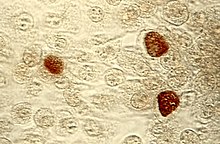| PVC superphylum | |
|---|---|

| |
| Chlamydia trachomatis | |
| Scientific classification (temporary) | |
| Domain: | Bacteria |
| Clade: | Hydrobacteria |
| Superphylum: | PVC superphylum |
| Phyla | |
|
Chlamydiota | |
| Synonyms | |
|
Planctobacteria Cavalier-Smith, 1987[1] | |
The PVC superphylum is a superphylum of bacteria named after its three important members, Planctomycetota, Verrucomicrobiota, and Chlamydiota.[2][3] Cavalier-Smith postulated that the PVC bacteria probably lost or reduced their peptidoglycan cell wall twice.[4] It has been hypothesised that a member of the PVC clade might have been the host cell in the endosymbiotic event that gave rise to the first proto-eukaryotic cell.[5][6]
Cavalier-Smith calls the same group Planctobacteria and considers it a phylum. However, this is not followed by the larger scientific community.[7] In the Cavalier-Smith bacterial megaclassification, it is within the bacterial Gracilicutes infra-kingdom and comprises the phyla Chlamydiota, Lentisphaerota, Planctomycetota, Verrucomicrobiota.[4][8]
| PVC superphylum[9][10][2][11] |
- ^ Cavalier-Smith, T (1987). "The origin of eukaryote and archaebacterial cells". Annals of the New York Academy of Sciences. 503 (1): 17–54. Bibcode:1987NYASA.503...17C. doi:10.1111/j.1749-6632.1987.tb40596.x. PMID 3113314. S2CID 38405158.
- ^ a b Wagner, M.; Horn, M. (2006). "The Planctomycetes, Verrucomicrobia, Chlamydiae and sister phyla comprise a superphylum with biotechnological and medical relevance". Current Opinion in Biotechnology. 17 (3): 241–249. doi:10.1016/j.copbio.2006.05.005. PMID 16704931.
- ^ Rivas-Marín, Elena; Devos, Damien P. (1 June 2018). "The Paradigms They Are a-Changin': past, present and future of PVC bacteria research". Antonie van Leeuwenhoek. 111 (6): 785–799. doi:10.1007/s10482-017-0962-z. PMC 5945725. PMID 29058138.
- ^ a b Cavalier-Smith, T (2002). "The neomuran origin of archaebacteria, the negibacterial root of the universal tree and bacterial megaclassification". International Journal of Systematic and Evolutionary Microbiology. 52 (Pt 1): 7–76. doi:10.1099/00207713-52-1-7. PMID 11837318.
- ^ Forterre, Patrick (January 2011). "A new fusion hypothesis for the origin of Eukarya: better than previous ones, but probably also wrong". Research in Microbiology. 162 (1): 77–91. doi:10.1016/j.resmic.2010.10.005. PMID 21034817.
- ^ Baum, David A; Baum, Buzz (28 October 2014). "An inside-out origin for the eukaryotic cell". BMC Biology. 12 (1): 76. doi:10.1186/s12915-014-0076-2. PMC 4210606. PMID 25350791.
- ^ Krieg, N.R.; Ludwig, W.; Whitman, W.B.; Hedlund, B.P.; Paster, B.J.; Staley, J.T.; Ward, N.; Brown, D.; Parte, A. (November 24, 2010) [1984(Williams & Wilkins)]. George M. Garrity (ed.). The Bacteroidetes, Spirochaetes, Tenericutes (Mollicutes), Acidobacteria, Fibrobacteres, Fusobacteria, Dictyoglomi, Gemmatimonadetes, Lentisphaerae, Verrucomicrobia, Chlamydiae, and Planctomycetes. Bergey's Manual of Systematic Bacteriology. Vol. 4 (2nd ed.). New York: Springer. p. 908. ISBN 978-0-387-95042-6. British Library no. GBA561951.
- ^ Cavalier-Smith T (2006). "Rooting the tree of life by transition analyses". Biol. Direct. 1 (1): 19. doi:10.1186/1745-6150-1-19. PMC 1586193. PMID 16834776.
- ^ Rappe, M. S.; Giovannoni, S. J. (2003). "The Uncultured Microbial Majority". Annual Review of Microbiology. 57: 369–394. doi:10.1146/annurev.micro.57.030502.090759. PMID 14527284.
- ^ Woese, C. R. (1987). "Bacterial evolution". Microbiological Reviews. 51 (2): 221–271. doi:10.1128/MMBR.51.2.221-271.1987. PMC 373105. PMID 2439888.
- ^ Stefan Spring, Boyke Bunk, Cathrin Spröer, Peter Schumann, Manfred Rohde, Brian J Tindall & Hans-Peter Klenk, (2016). Characterization of the first cultured representative of Verrucomicrobia subdivision 5 indicates the proposal of a novel phylum. Nature.